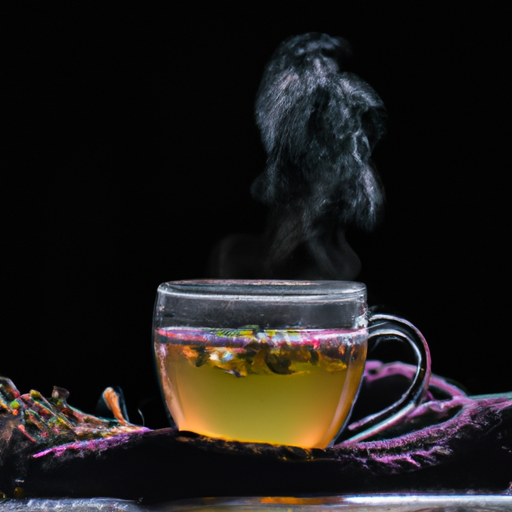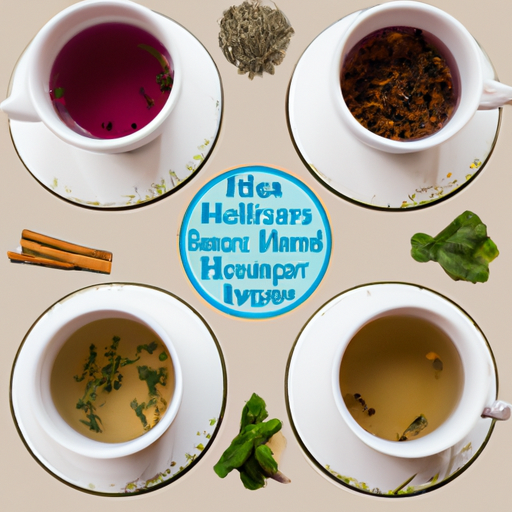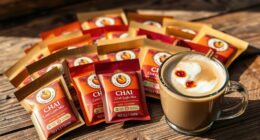Are you tired of the same old tea options? Looking for a hot beverage that will surprise and delight your taste buds? Well, look no further! I’m here to introduce you to the world of herbal infusions, a hot herbal drink that will revolutionize your beverage experience.
Imagine a drink that bursts with flavor, yet contains no tea. It may sound impossible, but trust me, it’s real! Herbal infusions are a delightful concoction of herbs, spices, and fruits steeped in hot water. They offer a tantalizing array of flavors and aromas that will transport you to a world of pure indulgence.
But it doesn’t stop there. Herbal infusions are not only delicious, but they also come with a multitude of health benefits. From soothing an upset stomach to boosting your immune system, these drinks are a true elixir of wellness.
In this article, we will explore the wonders of herbal infusions, from their benefits to the popular ingredients used. I’ll even share some tips on how to make a delicious herbal infusion that will impress your friends and family.
So, join me on this journey and let’s embrace the world of herbal infusions together!
Key Takeaways
- A hot herbal drink that has no tea in it is called a herbal infusion.
- Herbal infusions are made by steeping herbs, spices, and fruits in hot water.
- Herbal infusions offer a wide range of flavors and aromas.
- Herbal infusions have numerous health benefits, such as soothing an upset stomach and boosting the immune system.
What are Herbal Infusions?
Herbal infusions, also known as tisanes, are delightful and caffeine-free hot drinks that offer a variety of health benefits. These natural beverages are made by steeping or brewing herbs, flowers, leaves, or other plant materials in boiling water.
There are countless types of herbal infusions, each with its own unique flavor profile and potential health properties. Traditional herbal remedies have been used for centuries to treat various ailments and promote well-being. Herbal infusions make the most of these natural remedies by extracting the beneficial compounds from the plants and infusing them into the hot water.
Chamomile, for example, is known for its calming effects and is often consumed before bedtime to promote relaxation and sleep. Peppermint, on the other hand, is commonly used to soothe digestive discomfort and freshen breath.
Other popular herbal infusions include ginger, lemon balm, nettle, and hibiscus, each offering its own set of health benefits. Ginger is known for its anti-inflammatory properties, lemon balm has been used to reduce anxiety and promote a sense of calm, nettle is rich in vitamins and minerals, and hibiscus is often consumed for its potential to support heart health.
Herbal infusions are a wonderful way to enjoy a comforting and flavorful hot drink while reaping the benefits of traditional herbal remedies. They provide a natural alternative to tea and coffee, making them a great choice for those seeking a caffeine-free beverage.
In the next section, we’ll explore the various benefits of herbal infusions.
Benefits of Herbal Infusions
Herbal infusions offer a range of benefits that can promote relaxation and provide stress relief. These hot herbal drinks, devoid of tea, are known for their calming properties that can help soothe the mind and body.
Additionally, herbal infusions can support digestive health by aiding in digestion and easing discomfort. They also have the potential to boost the immune system, thanks to the natural compounds found in herbs that can enhance the body’s defense mechanisms.
Relaxation and Stress Relief
Nothing beats curling up with a warm, soothing brew that melts away stress and invites relaxation. When it comes to relaxation techniques and natural remedies, a hot herbal drink can’t be beat. Here are four reasons why it’s the perfect choice for unwinding:
-
Calming herbs: Many herbal infusions contain ingredients like chamomile, lavender, and lemon balm known for their calming properties. Sipping on these herbs can help ease anxiety and promote relaxation.
-
Stress relief: Herbal drinks can act as stress relievers by reducing cortisol levels in the body. This can result in a calmer mind and a more peaceful state of being.
-
Sleep aid: Certain herbs, like valerian root and passionflower, have sedative effects that can help combat insomnia and improve sleep quality. A cup of hot herbal drink before bed can promote a restful night’s sleep.
-
Ritualistic experience: Preparing and savoring a hot herbal drink can become a mindful practice, allowing you to focus on the present moment and create a sense of tranquility.
As we transition to the next section about digestive health, it’s important to note that a relaxed mind often goes hand in hand with a healthy gut.
Digestive Health
Improve your digestive health and experience a new level of vitality and well-being. When it comes to maintaining a healthy gut, incorporating gut-friendly beverages into your daily routine can make a significant difference.
These natural remedies for indigestion can help soothe your stomach and promote optimal digestion. One such beverage is a hot herbal drink, which isn’t only soothing but also packed with digestive benefits. This drink, often made with herbs like ginger, chamomile, or peppermint, can help alleviate indigestion, bloating, and discomfort. It works by relaxing the muscles of the gastrointestinal tract and reducing inflammation.
By incorporating this herbal drink into your routine, you can support a healthy digestive system and enjoy improved overall well-being.
Boosting your immune system is the next step in achieving optimal health and vitality.
Boosting Immune System
Boost your immune system by incorporating a powerful elixir that acts as a shield against illnesses and restores balance within you. You can nourish your body’s defense system and unlock its full potential. Boosting your immune system is essential, especially during cold and flu season. Luckily, there are numerous immune-boosting recipes and natural remedies that can help you stay healthy.
These remedies often include ingredients like ginger, turmeric, garlic, and echinacea. These ingredients are known for their immune-boosting properties. Ginger, for example, is rich in antioxidants that strengthen your immune system. Turmeric has anti-inflammatory properties that support overall health. Garlic is a powerful immune booster due to its antimicrobial properties. Echinacea is believed to enhance the body’s natural defense mechanisms.
By incorporating these natural ingredients into your daily routine, you can fortify your immune system and reduce the risk of falling ill.
Transitioning into the subsequent section about popular herbal ingredients, you’ll discover the key components that make these recipes so effective.
Popular Herbal Ingredients
Try adding some fresh mint leaves to your hot herbal drink for a refreshing and aromatic twist. Mint is just one of the many popular herbal ingredients that can be used to create delicious and healthy herbal remedies.
If you’re looking for herbal tea alternatives, here are four other ingredients you can consider incorporating into your hot drink:
-
Chamomile: Known for its calming properties, chamomile can help relax your body and mind. It has a light and floral flavor that pairs well with other herbs.
-
Ginger: Adding a slice of ginger to your drink can provide a warming and spicy kick. Ginger is also known for its anti-inflammatory properties and can aid digestion.
-
Lemon balm: With its citrusy aroma, lemon balm adds a refreshing twist to any hot herbal drink. It’s believed to have mood-boosting effects and can help reduce anxiety.
-
Lavender: Known for its soothing and relaxing properties, lavender can be a great addition to your herbal drink. It has a floral and slightly sweet flavor that complements other herbs well.
By incorporating these herbal ingredients into your hot drink, you can create a delicious and beneficial herbal infusion.
Now, let’s explore how to make this infusion even more enjoyable.
How to Make a Delicious Herbal Infusion
Indulge in the art of crafting a delectable herbal infusion that’ll tantalize your taste buds and transport you to a world of soothing flavors and aromatic bliss.
When it comes to making a delicious herbal infusion, choosing the right herbal ingredients is key. Each herb has its own unique flavor profile and health benefits, so it’s important to select ones that complement each other and suit your preferences. Some popular herbal ingredients include chamomile, peppermint, ginger, and lavender.
Once you’ve chosen your desired herbs, it’s time to brew your infusion. There are several different methods you can use, depending on the flavors and properties you want to extract from the herbs. One common method is steeping, where you pour hot water over the herbs and let them sit for a few minutes to infuse their flavors. Another method is decoction, where you simmer the herbs in water for a longer period of time to extract more potent flavors.
As you savor the delightful flavors of your homemade herbal infusion, it’s important to consider the health benefits these herbs can provide. From promoting relaxation and reducing inflammation to aiding digestion and boosting immunity, herbal infusions can be a wonderful addition to your wellness routine.
Next, let’s explore some important health considerations to keep in mind when enjoying herbal infusions.
Health Considerations
When it comes to enjoying a delicious infusion, it’s important to consider some health considerations.
For those looking for healthy alternatives or caffeine-free options, herbal drinks are a great choice. Unlike tea, which is made from the leaves of the Camellia sinensis plant, herbal infusions are made from a variety of herbs, flowers, and spices. This means they’re naturally caffeine-free, making them a perfect choice for those who’re sensitive to caffeine or looking to reduce their intake.
Herbal infusions offer a wide range of health benefits. Depending on the specific herbs used, they can aid digestion, boost the immune system, promote relaxation, or provide relief from common ailments like headaches or insomnia. Some popular herbs used in herbal infusions include chamomile, peppermint, ginger, and hibiscus, each with its own unique flavor profile and potential health benefits.
When choosing herbal infusions, it’s important to consider your specific health needs and preferences. If you’re looking to relax and unwind, chamomile or lavender infusions can be soothing choices. For a refreshing and invigorating drink, peppermint or lemon verbena infusions are excellent options. Consider the flavors and effects you desire, and experiment with different herbal combinations to find your perfect cup.
In the next section, we’ll explore herbal infusions for different occasions, including morning pick-me-ups, afternoon relaxation, and bedtime rituals.
Herbal Infusions for Different Occasions
Sip on these flavorful blends to transport your taste buds to different moments throughout the day. Herbal infusions are a wonderful way to enjoy the benefits of herbs without the caffeine found in tea. Whether you’re looking to wind down before bed or need a pick-me-up in the morning, there’s an herbal infusion recipe for every occasion.
For a soothing and sleep-inducing blend, try chamomile and lavender. Simply steep a teaspoon of dried chamomile flowers and a teaspoon of dried lavender in hot water for about 5 minutes. This fragrant infusion will help calm your mind and prepare you for a restful night’s sleep.
If you’re in need of an energy boost, consider making a blend of peppermint and rosemary. Steep a teaspoon of dried peppermint leaves and a teaspoon of dried rosemary leaves in hot water for 5-7 minutes. The refreshing aroma and invigorating properties of these herbs will help wake you up and keep you focused throughout the day.
Embrace the world of herbal infusions and discover the endless possibilities they offer. From calming chamomile and lavender blends to energizing peppermint and rosemary concoctions, there’s an herbal infusion for every mood and occasion. So why not indulge in a delicious and caffeine-free hot drink that’ll not only satisfy your taste buds but also provide numerous health benefits?
Conclusion: Embrace the World of Herbal Infusions
So why not explore the world of herbal infusions and unlock a whole new realm of delightful and caffeine-free concoctions? Herbal infusions offer a wide range of benefits, not only for our physical health but also for our emotional well-being.
These natural remedies have been used for centuries to promote relaxation, relieve stress, and enhance overall wellness.
Here are four reasons why embracing the world of herbal infusions can be beneficial for your emotional well-being:
-
Calming effects: Certain herbs like chamomile, lavender, and lemon balm have calming properties that can help reduce anxiety and promote a sense of tranquility.
-
Mood boosters: Herbs like peppermint, rosemary, and ginseng can help uplift your mood, providing a natural pick-me-up when you’re feeling down.
-
Stress relief: Adaptogenic herbs like ashwagandha, holy basil, and rhodiola can help your body adapt to stress and support your overall resilience.
-
Better sleep: Herbal infusions such as valerian root, passionflower, and chamomile can promote relaxation and improve the quality of your sleep.
By incorporating these herbal infusions into your daily routine, you can enhance your emotional well-being and enjoy the numerous benefits that nature has to offer. So why not give it a try and indulge in the soothing power of herbal infusions?
Frequently Asked Questions
Can herbal infusions be made with different types of water, such as sparkling or flavored water?
Yes, herbal infusions can be enhanced by using different types of water, such as sparkling or flavored water. This can add a unique twist to the flavor profile. Additionally, herbal infusions are often used as a natural remedy for digestion issues.
Are there any herbal infusions that can help with weight loss?
Herbal infusions can aid in weight loss by boosting metabolism and suppressing appetite. These natural drinks, made from various herbs, can provide a healthy and effective way to support your weight loss journey.
Can herbal infusions be consumed by pregnant women?
Herbal infusions during pregnancy can be safe if consumed in moderation. However, it is important to consult with a healthcare professional before adding them to your routine. Some herbal infusions may potentially affect the baby’s development.
Are there any herbal infusions that can help with improving sleep quality?
Herbal infusions, like chamomile or lavender, can be soothing bedtime elixirs, lulling you into a slumber as peacefully as a babbling brook. They have calming effects on anxiety and aid digestion, promoting improved sleep quality.
Can herbal infusions be made with fresh herbs instead of dried ones?
Fresh herbs can be used to make herbal infusions, but they may have a milder flavor compared to dried herbs. The choice between fresh and dried herbs depends on personal preference and the desired intensity of the herbal drink.
Conclusion
In conclusion, I must say that delving into the realm of herbal infusions is truly a journey worth undertaking. These enchanting elixirs, devoid of tea, offer a plethora of benefits for both body and soul.
By embracing the art of crafting a delightful herbal infusion, one can unlock a world of flavors and aromas that’ll tantalize the senses. So, let’s not shy away from this exquisite concoction, but rather, let’s revel in its refined elegance and indulge in its resplendent charm.










